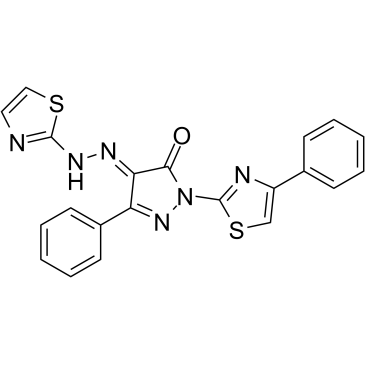| DC59120 |
BTSA1.2
|
BTSA1.2 is a rationalized BTSA1 analog with improved binding to BAX, cellular cytotoxicity, and better toleratence in vivo. Combination of BTSA1.2 with Navitoclax demonstrates synergistic efficacy in apoptosis-resistant cancer cells, xenografts, and patient-derived tumors while sparing healthy tissues. |
| DC70934 |
ZH97
|
ZH97 is a selective and covalent small-molecule inhibitor of BFL-1 protein with binding Ki of 0.41 uM, >200-fold selectivity over MCL-1.ZH97 does not bind to BCL-xL, BCL-2, TEAD2, TEAD4, MDM2, MDMX, BRD2 BD1, BRD2 BD2, BRD3 BD1, BRD3 BD2, BCL9, PD1/PD-L1 (Ki>400 uM).ZH97 modifies BFL-1 at the C55 residue, blocks BFL-1/BID interaction in vitro.ZH97 dose-dependently increased cytoplasmic cytochrome c level in U937 cells, has cell growth inhibition with IC50 of 2.8 uM, 5.5 uM, 7.7 uM, 6.8 uM, and 3.9 uM in U937, Kasumi-1, K562, MM.1S, and MV4-11 cell lines, respectively.ZH97 inhibits BFL-1/PUMA interaction in cell lysate and is effective in cancer cells that harboring highexpression level of BFL-1. |
| DC70246 |
BFL-1 inhibitor 4E14
|
BFL-1 inhibitor 4E14 (4E14) is a potent, selective, covalent BFL-1 inhibitor that disrupt BH3-binding activity with IC50 of 1.3 uM, targets a unique C55 residue in the BFL-1 groove.4E14 blocks BFL-1 suppression of BAX-mediated mitochondrial apoptosis. |
| DC50166 |
Bim-IN-1
|
Bim-IN-1 is a potent Bim expression inhibitor. Bim-IN-1 reduces Bim expression levels and has little inhibitory effect upon protein kinase A activity and minimal toxicity. |
| DC28441 |
BTSA1
|
BTSA1 is a potent, high affinity and orally active BAX activator with an IC50 of 250 nM and an EC50 of 144 nM. BTSA1 binds with high affinity and specificity to the N-terminal activation site and induces conformational changes to BAX leading to BAX-mediat |
| DC12064 |
VU0661013
|
VU661013 is a potent and selective MCL-1 inhibitor. |
| DC8444 |
Sabutoclax
|
Sabutoclax(BI-97C1) is a pan-Bcl-2 inhibitor, including Bcl-xL, Bcl-2, Mcl-1 and Bfl-1 with IC50 of 0.31 μM, 0.32 μM, 0.20 μM and 0.62 μM, respectively. |
| DC10137 |
S63845
|
S63845 is a potent and selective myeloid cell leukemia 1 (MCL1) inhibitor; binds human MCL1 with a Kd of 0.19 nM. |
| DC12163 |
S55746 (BLC201)
|
S55746 (BLC201) is a potent, orally active and selective BCL-2 inhibitor, with a Ki of 1.3 nM and a Kd of 3.9 nM. S55746 (BLC201) has antitumor activity with low toxicity[1]. |
| DC7233 |
Pifithrin-u
|
Pifithrin-μ is a specific p53 inhibitor by reducing its affinity to Bcl-xL and Bcl-2, and also inhibits HSP70 function and autophagy. |






















